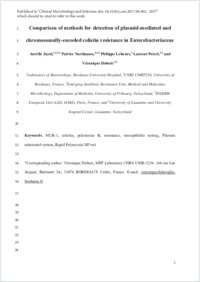Comparison of methods for detection of plasmid-mediated and chromosomally encoded colistin resistance in Enterobacteriaceae
- Jayol, Aurélie Laboratory of Bacteriology, Bordeaux University Hospital, France - CNRS UMR5234, University of Bordeaux, France - Emerging Antibiotic Resistance Unit, Medical and Molecular Microbiology, Department of Medicine, University of Fribourg, Switzerland - INSERM European Unit (LEA, IAME), Paris, France
- Nordmann, Patrice Emerging Antibiotic Resistance Unit, Medical and Molecular Microbiology, Department of Medicine, University of Fribourg, Switzerland - INSERM European Unit (LEA, IAME), Paris, France - University of Lausanne and University hospital Center, Lausanne, Switzerland
- Lehours, Philippe Laboratory of Bacteriology, Bordeaux University Hospital, France
- Poirel, Laurent Emerging Antibiotic Resistance Unit, Medical and Molecular Microbiology, Department of Medicine, University of Fribourg, Switzerland - INSERM European Unit (LEA, IAME), Paris, France
- Dubois, Véronique Laboratory of Bacteriology, Bordeaux University Hospital, France - CNRS UMR5234, University of Bordeaux, France
-
09.06.2017
Published in:
- Clinical Microbiology and Infection. - 2018, vol. 24, no. 2, p. 175-179
English
Objectives: Because of the emergence of plasmid-mediated (mcr-1 and mcr-2 genes) and chromosomally encoded colistin resistance, reliable methods for detecting colistin resistance/susceptibility in routine laboratories are required. We evaluated the respective performances of the BD Phoenix automated system, the newly developed Rapid Polymyxin NP test and the broth microdilution (BMD) reference method to detect colistin resistance in Enterobacteriaceae, and particularly those producing mcr-1 and mcr-2.Methods: Colistin susceptibility of 123 enterobacterial clinical isolates (40 colistin-susceptible and 83 colistin-resistant isolates) was tested with the BD Phoenix automated system, the Rapid Polymyxin NP test and the BMD method. Molecular mechanisms responsible for plasmid-mediated and chromosomally encoded colistin resistance mechanisms were investigated by PCR and sequencing.Results: Considering BMD as a reference method, the BD Phoenix system failed to detect ten colistin-resistant isolates (one Escherichia coli, one Klebsiella pneumoniae, seven Enterobacter species and one Salmonella enterica). The Rapid Polymyxin NP test failed to detect the same single E. coli isolate. Those two latter methods detected the 16 E. coli, K. pneumoniae and S. enterica isolates producing the plasmid-encoded mcr-1 and mcr-2.Conclusions: The BD Phoenix system and the Rapid Polymyxin NP test are reliable techniques for detecting plasmid-mediated mcr-1 and mcr-2-related colistin resistance. However, a high rate of false susceptibility was observed with the BD Phoenix system, indicating that susceptibility results obtained with that system should be confirmed by BMD method. By contrast, the Rapid Polymyxin NP test showed a good agreement with the BMD method, and results were obtained rapidly (within 2 hours). The BMD method should be performed if minimum inhibitory concentration values are needed
- Faculty
- Faculté des sciences et de médecine
- Department
- Médecine 3ème année
- Language
-
- English
- Classification
- Biological sciences
- License
-
License undefined
- Identifiers
-
- RERO DOC 305105
- DOI 10.1016/j.cmi.2017.06.002
- Persistent URL
- https://folia.unifr.ch/unifr/documents/306012
Statistics
Document views: 118
File downloads:
- pdf: 227
